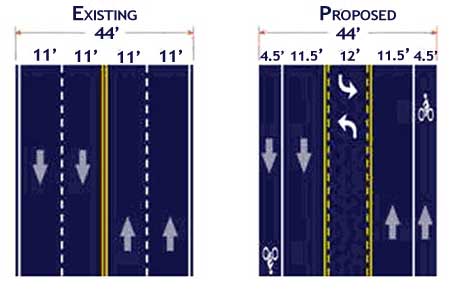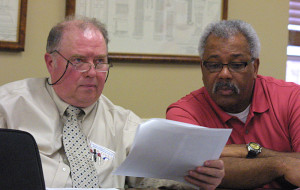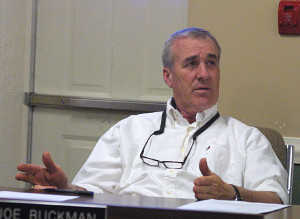State ‘road diet’ will reduce North Third from 4 lanes to 3 from Beall to KY245

A “road diet” proposed for North Third Street from Beall to KY 245 will reduce the existing 4 lanes to 2 with a shared turning lane.
By JIM BROOKS
Nelson County Gazette

Councilmen Tommy Reed and Roland Williams look over Transportation Cabinet documents during a discussion of a “road diet” that will reduce from 4 to 3 lanes North Third Street from Beall Avenue to the KY 245 intersection. Click to enlarge.
Tuesday, April 1, 2014 — The flow of traffic on North Third Street between Beall Avenue and the KY 245 intersection may soon change in significant and important ways if the Bardstown City Council adopts suggestions presented during Tuesday’s council work session.
Instead of the current four lanes, state Transportation officials are recommending a “road diet” that will reduce the number of lanes from four to three — one northbound lane, one southbound lane and a shared center turn lane used by both north and southbound traffic.
The purpose of the changes is to improve safety in that segment of North Third Street, which has been the site of numerous accidents and one fatality in the past three years, Charlie Allen, planning section supervisor from the District 4 Transportation Cabinet office in Elizabethtown.
“The corridor from Beall Avenue to 245 is one of our highest crash corridors in our district,” Allen told the council.
A similar project was completed on US31W in Elizabethtown from downtown to the area just south of Hardin Memorial Hospital, and the result was a greatly reduced number of accidents, he said.
The lane changes will also allow the addition of bicycle lanes in that same stretch of highway if desired, according to Brad Bottoms, the branch manager of project development at the E’town district office.
North Third between Beall and KY 245 currently consists of four lanes, each 11 feet wide. The revision will create two lanes 11-1/2 feet wide and a center lane 13 feet wide.
Bottoms said studies prove that a lane-reduction “diet” reduces accidents as much as 25 percent and improves safety for both motorists and pedestrians.
The plan — if the council approves — is to re-stripe the existing roadway as a trial period prior to the resurfacing project begins. This will allow a trial period for the new lane configuration that can identify problem areas.

Councilman Joe Buckman asks Transportation Cabinet officials about proposed “road diet” and how the flow of traffic will be impacted by school buses that must stop at the R.J.Corman railroad tracks on North Third Street. Click to enlarge.
The state is planning to resurface North Third Street later this year between the railroad tracks and KY 245, Bottoms said. The district engineers will also find funding to resurface the block between the tracks and Beall Street. “It’s the perfect time to consider making these changes,” Bottoms said.
Councilman John Royalty called the area between Daugherty Avenue and the Conway-Heaton dealership a “war zone” due to the congestion and traffic accidents.
The new lane configuration will have minimal impact on the time it takes to travel from KY245 and Beall Avenue. The lane reduction will slow traffic down.
Councilman Joe Buckman asked how the lane reduction will impact school buses and tanker trucks that are required to make complete stops at railroad crossings.
Bottoms said the R.J. Corman railroad tracks were a concern because school buses and other vehicles required to stop will also stop all the traffic behind them. The trial period will help identify if the railroad tracks are an issue with the flow of traffic.
The road diet project on US31W in Elizabethtown was met with considerable opposition, Bottoms told the council. Once it was completed however, the changes have helped traffic flow and improved safety.
The temporary striping can be completed within the next month or two, Bottoms said, stating he would prefer to do the temporary striping while school is still in session.
The council will consider the road diet at its next meeting on Tuesday, April 8.
WHOLESALE POWER DEADLINE. The city’s source of wholesale power has been Kentucky Utilities for years, but Bardstown, along with a group of Kentucky municipally-owned electric utilities, are facing an April 23 deadline for giving KU notice if they plan to change providers.
KU requires a five-year notice to terminate a wholesale electric power contract, and it is pushing for a 10-year notice.
For municipally owned electric utilities, the decision rests partly on figuring out which form of electricity generation is going to be the most economical and has the best chances of meeting future environmental regulations, Jeff Mills, city electrical engineer explained.
KU wants long-term commitments from wholesale customers so that it can better plan its investments in new power generation technology. For cities like Bardstown, there are other sources of wholesale electricity that may offer better rates in the long-term and also meet future environmental regulations.
There’s not a lot of time to study the issue, Public Works Director Larry Hamilton told the council.
An unknown factor facing power generation facilities are how coming regulations on carbon dioxide emissions will affect their costs. If a wholesaler is forced to add emission controls to meet new regulations, those costs will be passed along to its customers — and eventually, the utility’s customers.
“How do you plan power plants for the future when you don’t know what the environmental laws are going to be?” Hamilton said.
The council and the other municipally owned Kentucky utilities will continue to study options.
A representative from one alternative source is set to present to the council in an executive session at the April 8 council session.
-30-







